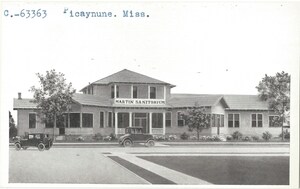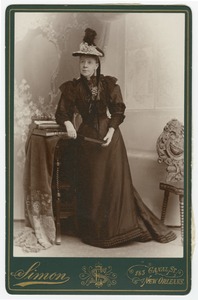This image, which dates to the early 1920s, depicts Martin Sanitorium in Picayune, Mississippi. Dr. Van Buren Martin (1867-1943), a physician and surgeon, established this hospital on West Canal Street in Picayune. This first image is the original publisher’s proof for a postcard of the hospital. Dr. Martin was born in Bogue Chitto in Lincoln County. He began his practice of medicine at Duncan in Bolivar County after graduating Ole Miss in 1892 and from Tulane Medical School in 1898, later moving to Bogue Chitto in 1910, Canton in 1915, and Picayune in Pearl River County by February 1918, where he established Martin Sanitorium, a modern medical and surgical hospital. Throughout the 1920s, the Mississippi Legislature, as it did for dozens of other hospitals in the state, appropriated $2,000 annually for the maintenance of a charity ward “containing not less than 10 beds…to be used for charity patients only” in the sanitorium (House Bill No. 399, Laws of 1924; see also Laws of 1922).
Dr. Martin was a prominent citizen in Picayune, serving as alderman of Ward One, the examining physician for the selective service system for local draft board No.1 of Pearl River County, member of the Board of Stewards of the First Methodist Church, former president of the Rotary Club, former bank director, as well as a member of the American Medical Association, the Mississippi State Medical Association, and the Mississippi Hospital Association. He died in New Orleans in February 1943 and is buried in New Palestine Cemetery in Picayune (The Weekly Democrat, Poplarville. March 4, 1943). After his death, Martin Sanitorium continued to operate as the primary hospital in Picayune until the 1954 construction of Crosby Memorial Hospital on Goodyear Boulevard there.
Picayune is located 24 miles southwest of Poplarville, the county seat of Pearl River County. The railroad came through in the 1880s, and Picayune, formerly known as Hobolochitto, was established in 1901, with a village created in 1904, a town in 1905, and the city of Picayune in 1922. Situated among longleaf yellow pine forests, the area had two large lumber mills, and later served as a tung tree center and as a residential area for the Stennis Space Center. On the banks of the Hobolochitto Creek lived Eliza Jane Poitevent (1849-1896), a pioneer newspaper woman who used the pseudonym “Pearl Rivers” and who in 1872 married the publisher of the New Orleans Daily Picayune, Alva M. Holbrook. After his death she inherited the paper, becoming the first woman owner of a major newspaper. In 1878, she married her business manager George Nicholson, and together, they erased the debt Holbrook left and greatly increased circulation of the paper. In the 1880s Eliza Jane was called upon to give a name to her native community, and she chose “Picayune” after her beloved newspaper, a word which traces its origins back to a Spanish coin, the “picayune,” the initial cost of the paper, equivalent to 6 and 1/4 cents. The newspaper once owned by Eliza Jane Poitevent Holbrook Nicholson is still published in New Orleans and is now the Times-Picayune. The second image is a cabinet card photograph of Eliza Jane taken in New Orleans between 1882 and 1894, which is part of The Historic New Orleans Collection. Note her hat with its grand ostrich plume and velvet ribbons, pearl earrings, the elaborate dress with black lace overlay, the fan, and her small corseted waist! If you have an old or even somewhat recent photograph which would be of interest to Mississippi physicians, please send it to me at drluciuslampton@gmail.com or by snail mail to the Journal.




